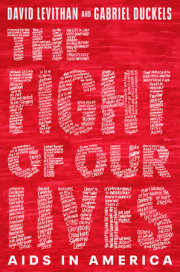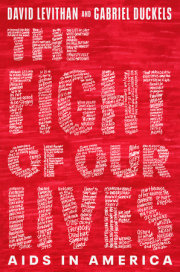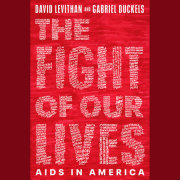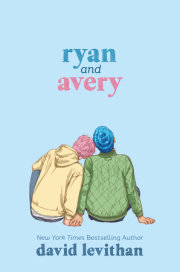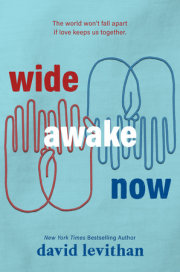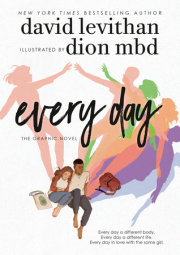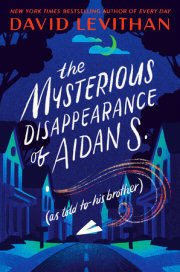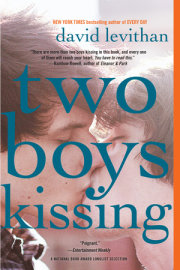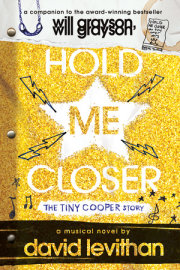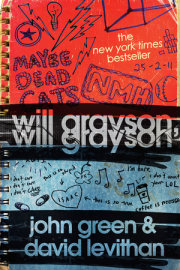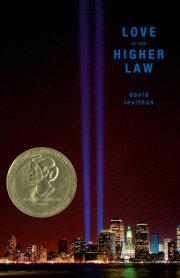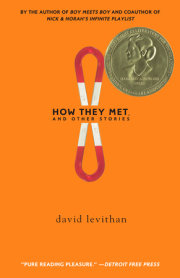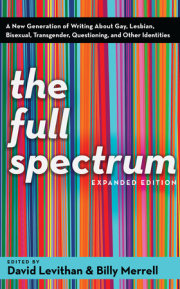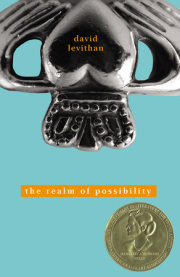A Brief Overview of the AIDS Epidemic, in Facts and FiguresWhen we talk about the AIDS crisis, we are most often describing a distinct period between the early 1980s and the mid-1990s when there was no treatment and AIDS spread unchecked around the world. First, there are the staggering numbers, the census of the sick and the dead. The figures below are from the Centers for Disease Control’s
HIV/AIDS Surveillance Report from 1980 through December 2001, the most accurate figures for the United States. Please keep in mind that because of the stigma involved, many AIDS cases went unreported and many AIDS deaths were said to have other causes—so these numbers are likely far lower than the real numbers. But even if they underrepresent, they still give a clear, painful view of the virus’s deadly trajectory.
(Sources for all facts and figures in this book can be found in the Notes section at the end.)
Before 1981: 100 new cases, 31 deathsThere is no single date when we can say the AIDS epidemic began. Because the virus can be present in the body for up to a decade before symptoms occur, it is impossible to pinpoint its emergence. As you will see in the case of Robert Rayford, there may have been isolated cases that went unnoticed by doctors before the 1980s. It is only when a few cases happen in a localized area that doctors begin to see a pattern.
1981: 339 new cases, 130 deathsThe first reports of a “gay pneumonia” or “gay cancer” appear in medical journals and local newspapers as clusters of young gay men in urban areas come down with unusual infections and/or a rare cancer called Kaposi’s sarcoma. Similar conditions are also found in infants in New York City who contracted it from their mothers, pointing to the fact that the disease is not, in fact, unique to gay men.
1982: 1,201 new cases, 466 deathsThe Centers for Disease Control (CDC) uses the term AIDS (acquired immune deficiency syndrome) for the first time, replacing GRID (gay-related immune Deficiency). The source of the disease and how it spreads are still unknown, nor is there any way to test for it. Cases are discovered in hemophiliacs, who have become infected through blood transfusions.
1983: 3,153 new cases, 1,511 deathsAIDS wards begin to appear in hospitals in major cities. The CDC adds female partners of men with AIDS as an “at-risk” group, and also warns blood banks of a possible problem with the US blood supply. Activists raise the alarm about a lack of funding to fight the disease while also cautioning the gay population in particular to be aware. French scientists discover the retrovirus—HIV (human immunodeficiency virus)—that causes AIDS.
1984: 6,368 new cases, 3,526 deathsAmerican scientists confirm the connection between HIV and AIDS.
1985: 12,044 new cases, 6,996 deathsThe first blood test is released to diagnose HIV/AIDS. And when famous actor Rock Hudson reveals he has AIDS, the world takes notice in a way it hasn’t before. President Reagan mentions AIDS for the first time in a speech. Meanwhile, a
Los Angeles Times poll finds that a majority of Americans favor quarantining people with AIDS. Patients are often subject to isolation, stigma, and ridicule—as shown in the treatment of hemophiliac teenager Ryan White, who is HIV+ and prevented from going to his school.
There are 89 percent more new cases in 1985 than in 1984. Of those who have been diagnosed with AIDS, 51 percent of all adults and 59 percent of all children have died.
1986: 19,404 new cases, 12,183 deathsDefying conservatives, the surgeon general issues a report encouraging the use of condoms, sex education, and voluntary testing to prevent the spread of AIDS. Meanwhile, the CDC reports that Black and Latine people are disproportionately affected by AIDS.
1987: 29,105 new cases, 16,488 deathsACT UP (AIDS Coalition to Unleash Power) is formed to protest governmental and corporate malfeasance in helping people with AIDS. AZT is the first drug approved by the FDA (Food and Drug Administration) to fight AIDS; it is highly (and often prohibitively) expensive and has many potentially toxic side effects.
1988: 36,126 new cases, 21,244 deathsGrassroots needle-exchange programs begin to help prevent intravenous drug users from infecting themselves through dirty needles.
1989: 43,499 new cases, 28,054 deathsThe National Commission on AIDS, formed by Congress, first meets. The number of new cases continues to grow, as AZT does not prove to be the cure that many hoped it would be.
1990: 49,546 new cases, 31,836 deathsACT UP protestors at the NIH (National Institutes of Health) demand more treatments, fast-track approvals of AIDS drugs, and a clinical trial system that is more inclusive, particularly of women and people of color.
1991: 60,573 new cases, 37,106 deathsThe red ribbon becomes the symbol of AIDS awareness. But even if people are talking about it, there is still no cure, and the infection rate is only rising.
1992: 79,657 new cases, 41,849 deathsAIDS becomes the leading cause of death for US men ages twenty-five to forty-four.
1993: 79,879 new cases, 45,733 deathsThe CDC expands its list of clinical indicators of AIDS to include pulmonary tuberculosis, recurrent pneumonia, and invasive cervical cancer, which leads to more accurate diagnoses in women and drug users.
1994: 73,086 new cases, 50,657 deathsAIDS is now the leading cause of death for all Americans ages twenty-five to forty-four.
1995: 69,984 new cases, 51,414 deathsThe number of cases of AIDS in the US passes five hundred thousand. The first protease inhibitor is approved for use in fighting AIDS. HAART (highly active antiretroviral therapy) becomes the newest treatment for people with AIDS.
1996: 61,124 new cases, 38,074 deathsThe HAART combination therapy proves to be effective, and the numbers of new cases and deaths decline for the first time in the epidemic. While AIDS is no longer the leading cause of death for all Americans ages twenty-five to forty-four, it is still the leading cause of death for Black Americans in that age range, highlighting the disparity of care.
1997: 49,379 new cases, 21,846 deathsUNAIDS (the Joint United Nations Programme on HIV/AIDS) estimates 30 million people worldwide have HIV. Meanwhile, the use of HAART in America leads to a 48 percent decline in deaths from AIDS.
1998: 41,829 new cases, 18,148 deathsThe CDC reports that Black Americans account for 49 percent of AIDS-related deaths in America. The AIDS-related mortality rate for Black people is ten times higher than the rate for white people and three times higher than the rate for Latine people.
1999: 38,811 new cases, 16,762 deathsAccording to the World Health Organization (WHO), AIDS has become the fourth biggest cause of death in the world and the biggest cause of death in Africa. It is estimated that 33 million people are living with AIDS and 14 million have died worldwide.
2000: 36,087 new cases, 14,499 deathsPresident Clinton announces the Millennium Initiative to find vaccines for HIV/AIDS and other diseases. (Twenty-five years after the millennium, there is still no HIV vaccine.)
2001: 24,855 new cases, 8,998 deathsIn the twenty years between 1981 and 2001, including cases where the year of death couldn’t be determined, there are 816,149 new cases and 467,910 deaths in the United States alone. To put that in perspective, 418,500 Americans died in all of World War II.
2002 to 2025:Throughout the 2000s, 2010s, and 2020s, the number of infections decreases overall within the United States but is still substantial. Transmission rates among gay men remain significant (especially in underserved communities, in terms of race and income), and there is an uptick when the opioid crisis creates a new generation of intravenous drug users. The “cocktail” of medications introduced with HAART continues to be an effective way to manage HIV, with treatment enabling people with HIV to maintain levels of the virus that are not transmittable or detectable. (The science of HIV/AIDS will be explained further in a later part of this book.)
CDC data for 2022 (the latest year for which we have data at the time of this book’s completion) says that 37,981 people ages thirteen and up were diagnosed with HIV in this year. Of these, 76 percent received care for HIV and 65 percent were virally suppressed, meaning they were undetectable and untransmittable. It is estimated there are 1.2 million people living with HIV in America by the end of 2022. In 2025, deep cuts to governmental funding for HIV/AIDS care and research have led to urgent concern that HIV rates and AIDS-related deaths will rise again in both the United States and abroad.
A Brief Overview of the AIDS Epidemic, Through the Story of My Uncle, Robert LevithanI [David] now want to rewind the overview and share it with you again, mapping it out against the life of my uncle Bobby, who you’ll be hearing from throughout this book. At the risk of giving away the ending, I will tell you that Bobby lived with HIV for over thirty years, and that my closest knowledge of AIDS comes from him. I share the overview of his story below with two caveats: First, I don’t mean to claim that Bobby— a white gay man from a supportive (emotionally and financially) family— is in any way emblematic of all people with AIDS. In fact, one of the biggest misstatements you can make in talking about AIDS is to imply that
anyone is emblematic of the very wide, very diverse population of people with AIDS. I’m sharing this one story to tell you one story, not to tell you anything more than that. Which leads to the second caveat: There was much more to my uncle than his HIV status, although as you’ll see later, he very proudly took on the mantle of AIDS counselor and AIDS elder. I want to introduce him now, in this way, to show you what these numbers mean against one man’s experience, before we use his own words to tell you more.
Before 1981: 100 new cases, 31 deathsRobert grew up the youngest of three brothers. (The oldest was my dad, the middle my uncle Jack.) His childhood was very suburban and very straight . . . although he sensed early on that he might be more into boys than girls. It wasn’t until he hit college in the 1970s that he found his crowd . . . and once he did, he plunged right into the dynamic, subversive wave of gay culture that moved through New York City after the Stonewall Riot. He was (among other things) an actor, a taxi driver, a waiter, an off-off-Broadway theatrical producer, a sound engineer, and a muse. He traveled through Italy with his lover, the photographer Peter Hujar, and was also photographed by contemporaries like Robert Mapplethorpe and Duane Michals. He danced in the movie version of
Hair. He went to the bars and had many boyfriends. He never settled down, even though there was a part of him that wanted to find someone worthy of the settling.
-- Samantha HolmesBook DeveloperScribe Inc.www.scribenet.commain telephone: 215-336-5094 ext. 114 direct telephone: 267-507-13017540 Windsor Drive Suite 200B, Allentown, PA 18195
Copyright © 2026 by David Levithan. All rights reserved. No part of this excerpt may be reproduced or reprinted without permission in writing from the publisher.


